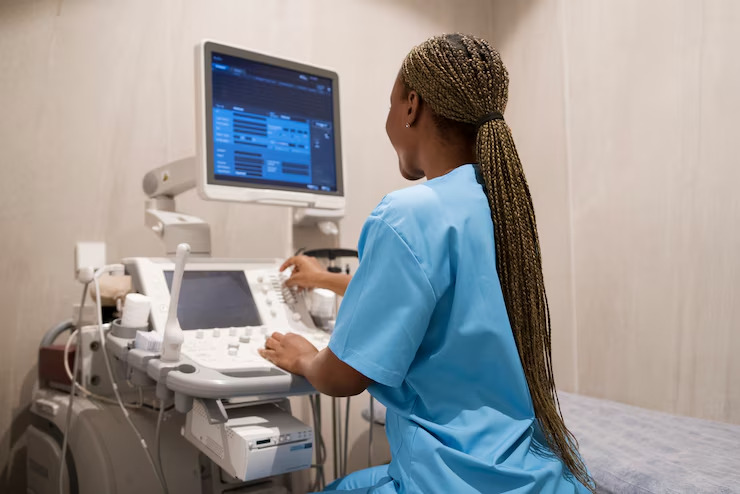Ultrasound is a painless and safe procedure used for imaging. It works by using sound waves to see inside the body. Physicians use it to hunt for problems, to steer treatments, and to monitor health. Ultrasound comes in many flavors, each with specific uses. Let’s discuss the primary kinds and how they’re employed.
Abdominal Ultrasound
It’s one of the better ones. It assists doctors in seeing organs including the liver, gallbladder, kidneys, pancreas and bladder. It is frequently used in cases where a person has pain in the gut or swelling.
Uses:
- Discover stones in the gallbladder or kidneys
- Keep track of Liver or kidney function
- Check for abdominal masses
Pelvic Ultrasound
Pelvic ultrasounds take a peek at the organs in your lower belly. This consists of the uterus, ovaries, and bladder in females, and the bladder and prostate in males.
Uses:
- Diagnose pelvic pain
- Monitor pregnancy
- Check for cysts or fibroids
Obstetric Ultrasound
This one is specifically made for pregnancy. It also helps to track a baby’s growth and look for any problems. The vast majority of pregnant women get at least one.
Uses:
- Confirm pregnancy
- Keep track of the baby’s health and positioning
- Check for birth defects
Transvaginal Ultrasound
This is a particular kind of pelvic ultrasound. A long, thin metal or plastic rod is inserted in a woman’s vagina to see the reproductive organs more clearly. It provides clearer images than a conventional pelvic scan.
Uses:
- Investigate abnormal bleeding
- Diagnose infertility causes
- Early pregnancy checks
Doppler Ultrasound
Doppler ultrasounds Target blood flow. They demonstrate how blood flows through veins and arteries. This form is helpful to screen for blood clots, blockages, or bad circulation.
Uses:
- Find blood clots
- Check for blocked arteries
- Monitor blood flow in organs
Musculoskeletal Ultrasound
This kind examines muscles, tendons and joints. It helps locate injuries such as sprains, or tears.
Uses:
- Diagnose sports injuries
- Guide joint injections
- Detect soft tissue damage
Breast Ultrasound
Breast ultrasound is frequently performed following a mammogram. It enables doctors to distinguish between a solid mass and one filled with fluid.
Uses:
- Examine lumps
- Guide needle biopsies
- Monitor known cysts
Point-of-Care Ultrasound in Emergency and Urgent Care Medicine
In emergencies, doctors might use ultrasound to rapidly figure out what’s wrong. For in-the-moment diagnosis, issues such as internal bleeding, fluid buildup and organ damage can be diagnosed through urgent care ultrasound.
When is it appropriate to do an ultrasound in urgent care?
This is being used by clinics who provide ultrasound urgent care to fasten diagnosis and alleviate diseases. It’s particularly useful when quick answers are required, and X-rays or CT scans are unavailable.
Final Thoughts
Ultrasound is a versatile and useful modality. It provides quick answers with no radiation. Whatever ails you — from pain to injury to pregnancy — there’s probably a type of ultrasound specially made to help you. Ultrasound is vital to patient care in both the hospital and the clinic, where it is available not only in the emergency room but also in urgent care clinics. To schedule your appointment with the highest standard of care and visit Sahara West Urgent Care, visit our website.
FAQs
Q1: Is ultrasound safe?
Yes, ultrasound is a safe and painless imaging method that uses sound waves, not radiation.
Q2: What are the main types of ultrasound?
The main types include abdominal, pelvic, obstetric, transvaginal, Doppler, musculoskeletal, breast, and point-of-care ultrasound for emergencies.
Q3: Can ultrasound detect pregnancy?
Yes, obstetric and transvaginal ultrasounds are used to confirm and monitor pregnancy.
Q4: When is a Doppler ultrasound needed?
Doppler ultrasound is used to evaluate blood flow, detect clots, blocked arteries, or poor circulation.
Q5: Is ultrasound used in emergencies?
Absolutely. Point-of-care Ultrasound is commonly used in urgent and emergency care settings for quick diagnosis of internal injuries, fluid buildup, or organ damage.





